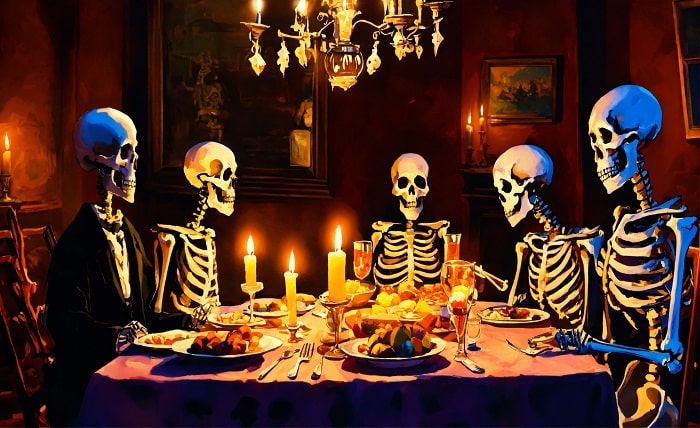The 1982 Movie Poltergeist Used Real Skeletons As – Tymoff: Unveiling the Horror Behind the Scenes

Introduction
The 1982 movie Poltergeist is a classic horror film that has terrified audiences for decades. However, what many people don’t know is that the 1982 movie Poltergeist used real skeletons as – tymoff, adding an eerie layer of authenticity to its chilling scenes. This controversial choice has sparked numerous debates and urban legends, making it a fascinating topic for horror enthusiasts and film historians alike. In this blog post, we will delve into the macabre behind-the-scenes details of Poltergeist, exploring the reasons, implications, and lasting impact of using real skeletons in the film.
The Birth of a Horror Classic
The 1982 movie Poltergeist, directed by Tobe Hooper and produced by Steven Spielberg, quickly became a landmark in the horror genre. The film’s storyline, special effects, and performances captivated audiences. But behind the scenes, an unsettling truth lingered – the 1982 movie Poltergeist used real skeletons as – tymoff in several scenes, particularly in the infamous swimming pool sequence. This decision has been shrouded in controversy and has contributed to the film’s legacy.
The Swimming Pool Scene: A Haunting Reality
One of the most iconic and terrifying scenes in Poltergeist is the swimming pool sequence, where the 1982 movie Poltergeist used real skeletons as – tymoff. Actress JoBeth Williams, who played Diane Freeling, found herself amidst real human remains during the filming. The use of real skeletons was intended to enhance the realism of the scene, but it also introduced an element of genuine horror that has resonated with audiences for years.
Why Real Skeletons Were Used
The decision to use real skeletons in the 1982 movie Poltergeist as – tymoff was primarily driven by practicality and budget constraints. At the time, real skeletons were more affordable and readily available than realistic plastic replicas. This choice, however, has been criticized for its ethical implications, as it involved the use of actual human remains in a commercial film production. The 1982 movie Poltergeist used real skeletons as – tymoff, highlighting a darker side of Hollywood’s production practices.
The Ethical Dilemma
The use of real skeletons in the 1982 movie Poltergeist as – tymoff raises significant ethical questions. The decision to include human remains in a film for the sake of realism blurs the line between artistic expression and exploitation. Many argue that the 1982 movie Poltergeist used real skeletons as – tymoff without proper consideration for the dignity and respect owed to the deceased. This aspect of the film’s production has sparked ongoing debates about the responsibilities of filmmakers towards the subjects of their work.
The Curse of Poltergeist
The 1982 movie Poltergeist used real skeletons as – tymoff, and this decision is often cited as a contributing factor to the so-called “Poltergeist curse.” Several cast members and crew experienced untimely deaths and unexplained accidents, leading to speculation that the use of real skeletons brought bad luck. While there is no concrete evidence to support these claims, the association between the film and these tragedies has only added to its mystique.
Audience Reactions and Urban Legends
The revelation that the 1982 movie Poltergeist used real skeletons as – tymoff has fueled numerous urban legends and conspiracy theories. Some viewers believe that the film’s supernatural elements were amplified by the presence of actual human remains, contributing to its lasting impact. The 1982 movie Poltergeist used real skeletons as – tymoff, and this fact has become a key part of its lore, intriguing and unsettling audiences to this day.
Legacy and Influence on Horror Cinema
The 1982 movie Poltergeist used real skeletons as – tymoff, setting a precedent for other horror films seeking to achieve a similar level of authenticity. While modern productions are more likely to use advanced special effects and props, the decision to use real skeletons in Poltergeist remains a controversial and influential moment in film history. It has inspired filmmakers to push the boundaries of realism and explore the ethical implications of their creative choices.
Behind-the-Scenes Stories
Many behind-the-scenes stories from the 1982 movie Poltergeist as – tymoff reveal the challenges and complexities of using real skeletons. Cast and crew members have shared their experiences of working with these macabre props, describing the eerie atmosphere on set. These anecdotes provide insight into the practical and emotional toll of incorporating real human remains into a film production.
Modern Perspectives on the Practice
Today, the practice of using real skeletons in films like the 1982 movie Poltergeist as – tymoff is viewed with greater scrutiny. Advances in technology have made it possible to create highly realistic replicas without the need for actual human remains. The ethical considerations surrounding this practice have also evolved, with a stronger emphasis on respect for the deceased and their families. The 1982 movie Poltergeist used real skeletons as – tymoff, but modern filmmakers are more likely to seek alternatives.
Conclusion
The 1982 movie Poltergeist used real skeletons as – tymoff, a decision that has left a lasting mark on the film’s legacy and the horror genre as a whole. This controversial choice has sparked debates about ethics, authenticity, and the responsibilities of filmmakers. While the practice of using real skeletons is largely a thing of the past, the story of Poltergeist serves as a chilling reminder of the lengths to which some filmmakers will go to achieve realism. The 1982 movie Poltergeist used real skeletons as – tymoff, and this fact continues to captivate and horrify audiences, ensuring its place in cinematic history.
FAQs
1. Why did the 1982 movie Poltergeist use real skeletons as – tymoff?
The 1982 movie Poltergeist used real skeletons as – tymoff primarily due to budget constraints and practicality. At the time, real skeletons were more affordable and readily available than realistic plastic replicas.
2. Were the real skeletons used in Poltergeist obtained ethically?
The ethical considerations surrounding the use of real skeletons in the 1982 movie Poltergeist as – tymoff are complex. While the skeletons were obtained legally, many argue that their use in a commercial film raises ethical concerns regarding the dignity and respect owed to the deceased.
3. Did the use of real skeletons contribute to the so-called “Poltergeist curse”?
The 1982 movie Poltergeist used real skeletons as – tymoff, and this decision is often cited as a contributing factor to the “Poltergeist curse.” Several cast and crew members experienced untimely deaths and unexplained accidents, leading to speculation about the film’s supernatural elements.
4. How did the cast and crew react to using real skeletons in Poltergeist?
The cast and crew of the 1982 movie Poltergeist as – tymoff had mixed reactions to using real skeletons. Some found it unsettling, while others viewed it as a necessary aspect of the production. Actress JoBeth Williams, who filmed scenes with the skeletons, later expressed her discomfort.
5. Is it common for movies to use real skeletons today?
Modern film productions are less likely to use real skeletons due to advances in special effects and ethical considerations. The 1982 movie Poltergeist used real skeletons as – tymoff, but contemporary filmmakers typically opt for realistic replicas and CGI to achieve the desired effects without ethical concerns.




